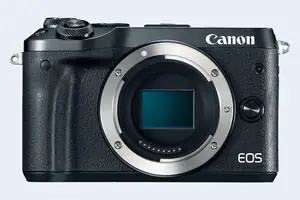Canon M6 vs Leica V-LUX 1
The Canon EOS M6 and the Leica V-LUX 1 are two digital cameras that were announced, respectively, in February 2017 and September 2006. The M6 is a mirrorless interchangeable lens camera, while the V-LUX 1 is a fixed lens compact. The cameras are based on an APS-C (M6) and a 1/1.8-inch (V-LUX 1) sensor. The Canon has a resolution of 24 megapixels, whereas the Leica provides 10 MP.
Below is an overview of the main specs of the two cameras as a starting point for the comparison.

Check M6 offers at
ebay.com

Check V-LUX 1 offers at
ebay.com
Going beyond this snapshot of core features and characteristics, what are the differences between the Canon EOS M6 and the Leica V-LUX 1? Which one should you buy? Read on to find out how these two cameras compare with respect to their body size, their imaging sensors, their shooting features, their input-output connections, and their reception by expert reviewers.
Body comparison
An illustration of the physical size and weight of the Canon M6 and the Leica V-LUX 1 is provided in the side-by-side display below. The two cameras are presented according to their relative size. Three successive views from the front, the top, and the rear are shown. All width, height and depth measures are rounded to the nearest millimeter.
The M6 can be obtained in two different colors (black, silver), while the V-LUX 1 is only available in black.
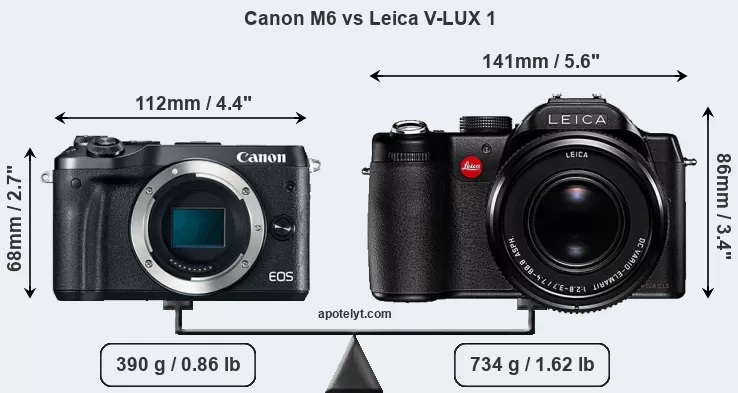
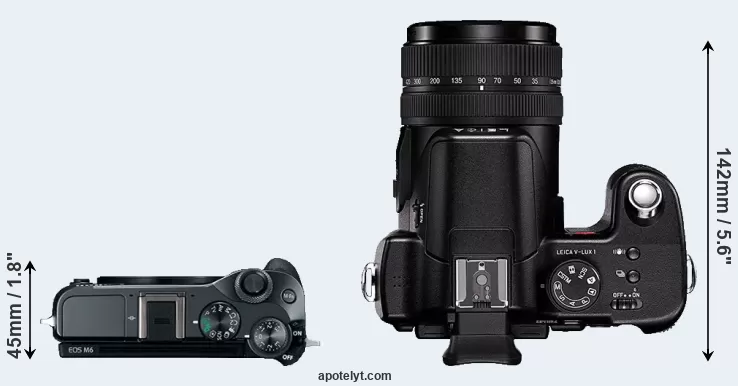
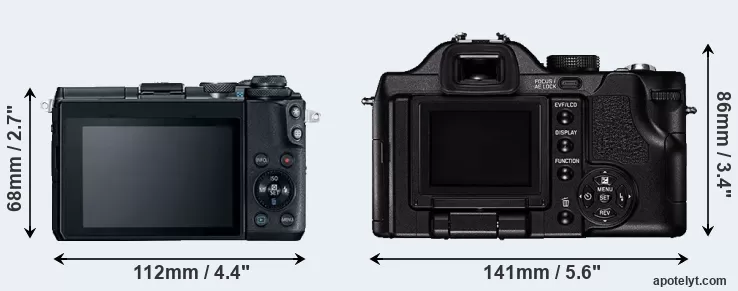
If the front view area (width x height) of the cameras is taken as an aggregate measure of their size, the Leica V-LUX 1 is considerably larger (59 percent) than the Canon M6. In this context, it is worth noting that neither the M6 nor the V-LUX 1 are weather-sealed.
The above size and weight comparisons are to some extent incomplete and possibly misleading, as the V-LUX 1 has a lens built in, whereas the M6 is an interchangeable lens camera that requires a separate lens. Attaching the latter will add extra weight and bulk to the setup.
The table below summarizes the key physical specs of the two cameras alongside a broader set of comparators. In case you want to display and compare another camera duo, you can use the CAM-parator app to select your camera combination among a large number of options.

| Camera Model |
Camera Width |
Camera Height |
Camera Depth |
Camera Weight |
Battery Life |
Weather Sealing |
Camera Launch |
Launch Price (USD) |
Street Price |
||
|---|---|---|---|---|---|---|---|---|---|---|---|
| 1. | Canon M6 | 112 mm | 68 mm | 45 mm | 390 g | 295 | n | Feb 2017 | 779 | ebay.com | |
| 2. | Leica V-LUX 1 | 141 mm | 86 mm | 142 mm | 734 g | 360 | n | Sep 2006 | 849 | ebay.com | |
| 3. | Canon 77D | 131 mm | 100 mm | 76 mm | 540 g | 600 | n | Feb 2017 | 899 | ebay.com | |
| 4. | Canon M3 | 111 mm | 68 mm | 44 mm | 366 g | 250 | n | Feb 2015 | 679 | ebay.com | |
| 5. | Canon M5 | 116 mm | 89 mm | 61 mm | 427 g | 295 | n | Sep 2016 | 979 | ebay.com | |
| 6. | Canon M6 Mark II | 120 mm | 70 mm | 49 mm | 408 g | 305 | n | Aug 2019 | 849 | ebay.com | |
| 7. | Canon M50 | 116 mm | 88 mm | 59 mm | 390 g | 235 | n | Feb 2018 | 779 | ebay.com | |
| 8. | Canon M100 | 108 mm | 67 mm | 35 mm | 302 g | 295 | n | Aug 2017 | 499 | ebay.com | |
| 9. | Canon SL2 | 122 mm | 93 mm | 70 mm | 453 g | 650 | n | Jun 2017 | 549 | ebay.com | |
| 10. | Canon T6i | 132 mm | 101 mm | 78 mm | 555 g | 440 | n | Feb 2015 | 749 | ebay.com | |
| 11. | Canon T6s | 132 mm | 101 mm | 78 mm | 565 g | 440 | n | Feb 2015 | 649 | ebay.com | |
| 12. | Leica D-LUX 5 | 110 mm | 65 mm | 43 mm | 271 g | 400 | n | Sep 2010 | 699 | ebay.com | |
| 13. | Leica D-LUX 6 | 111 mm | 68 mm | 46 mm | 298 g | 330 | n | Sep 2012 | 699 | ebay.com | |
| 14. | Leica V-LUX 2 | 124 mm | 80 mm | 95 mm | 520 g | 410 | n | Sep 2010 | 849 | ebay.com | |
| 15. | Leica V-LUX 4 | 125 mm | 87 mm | 110 mm | 588 g | 540 | n | Sep 2012 | 949 | ebay.com | |
| 16. | Nikon D80 | 132 mm | 103 mm | 77 mm | 668 g | 600 | n | Aug 2006 | 999 | ebay.com | |
| 17. | Nikon D5600 | 124 mm | 97 mm | 70 mm | 465 g | 970 | n | Nov 2016 | 699 | ebay.com | |
| Note: Measurements and pricing do not include easily detachable parts, such as add-on or interchangeable lenses or optional viewfinders. | |||||||||||
Any camera decision will naturally be influenced heavily by the price. The manufacturer’s suggested retail prices give an idea on the placement of the camera in the maker’s lineup and the broader market. Usually, retail prices stay at first close to the launch price, but after several months, discounts become available. Later in the product cycle and, in particular, when the replacement model is about to appear, further discounting and stock clearance sales often push the camera price considerably down.
Sensor comparison
The size of the sensor inside a digital camera is one of the key determinants of image quality. All other things equal, a large sensor will have larger individual pixel-units that offer better low-light sensitivity, wider dynamic range, and richer color-depth than smaller pixels in a sensor of the same technological generation. Moreover, a large sensor camera will give the photographer more control over depth-of-field in the image and, thus, the ability to better isolate a subject from the background. On the downside, larger sensors tend to be associated with larger, more expensive camera bodies and lenses.
Of the two cameras under consideration, the Canon M6 features an APS-C sensor and the Leica V-LUX 1 a 1/1.8-inch sensor. The sensor area in the V-LUX 1 is 89 percent smaller. As a result of these sensor size differences, the cameras have a format factor of, respectively, 1.6 and 4.8. The sensor in the M6 has a native 3:2 aspect ratio, while the one in the V-LUX 1 offers a 4:3 aspect.
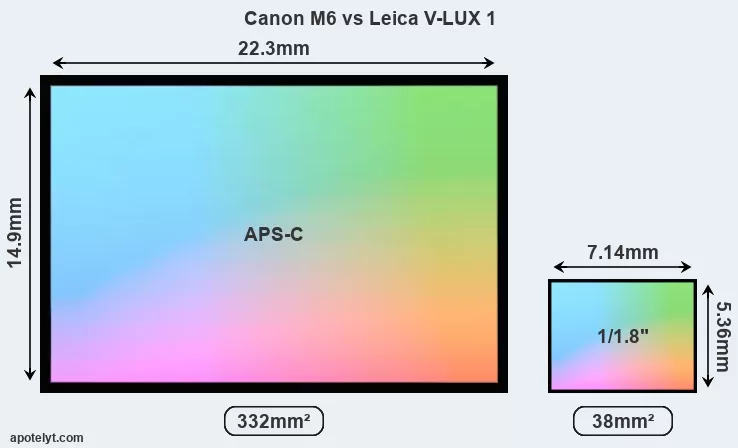
With 24MP, the M6 offers a higher resolution than the V-LUX 1 (10MP), but the M6 nevertheless has larger individual pixels (pixel pitch of 3.72μm versus 1.95μm for the V-LUX 1) due to its larger sensor. Moreover, the M6 is a much more recent model (by 10 years and 5 months) than the V-LUX 1, and its sensor will have benefitted from technological advances during this time that further enhance the light gathering capacity of its pixels. Coming back to sensor resolution, it should be mentioned that the V-LUX 1 has no anti-alias filter installed, so that it can capture all the detail its sensor resolves.
The resolution advantage of the Canon M6 implies greater flexibility for cropping images or the possibility to print larger pictures. The maximum print size of the M6 for good quality output (200 dots per inch) amounts to 30 x 20 inches or 76.2 x 50.8 cm, for very good quality (250 dpi) 24 x 16 inches or 61 x 40.6 cm, and for excellent quality (300 dpi) 20 x 13.3 inches or 50.8 x 33.9 cm. The corresponding values for the Leica V-LUX 1 are 18.2 x 13.7 inches or 46.3 x 34.7 cm for good quality, 14.6 x 10.9 inches or 37.1 x 27.8 cm for very good quality, and 12.2 x 9.1 inches or 30.9 x 23.2 cm for excellent quality prints.
The M6 has on-sensor phase detect pixels, which results in fast and reliable autofocus acquisition even during live view operation.
The Canon EOS M6 has a native sensitivity range from ISO 100 to ISO 25600. The corresponding ISO settings for the Leica V-LUX 1 are ISO 100 to ISO 1600, with the possibility to increase the ISO range to 100-3200.
Technology-wise, both cameras are equipped with CMOS (Complementary Metal–Oxide–Semiconductor) sensors. Both cameras use a Bayer filter for capturing RGB colors on a square grid of photosensors. This arrangement is found in most digital cameras.
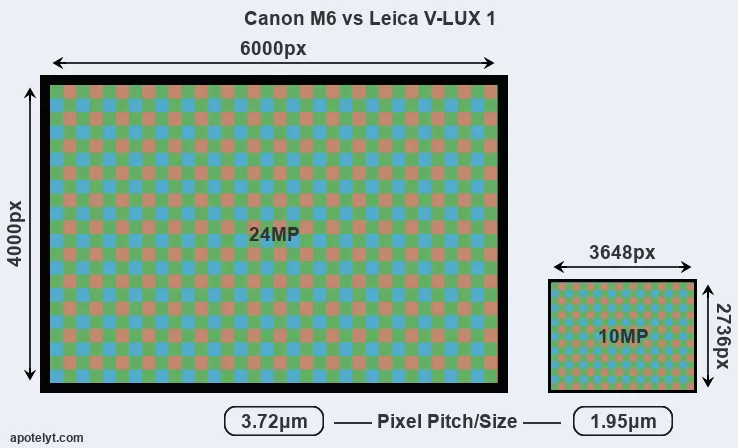
Consistent information on actual sensor performance is available from DXO Mark for many cameras. This service is based on lab testing and assigns an overall score to each camera sensor, as well as ratings for dynamic range ("DXO Landscape"), color depth ("DXO Portrait"), and low-light sensitivity ("DXO Sports"). The following table provides an overview of the physical sensor characteristics, as well as the sensor quality measurements for a selection of comparators.

| Camera Model |
Sensor Class |
Resolution (MP) |
Horiz. Pixels |
Vert. Pixels |
Video Format |
DXO Portrait |
DXO Landscape |
DXO Sports |
DXO Overall |
||
|---|---|---|---|---|---|---|---|---|---|---|---|
| 1. | Canon M6 | APS-C | 24.0 | 6000 | 4000 | 1080/60p | 23.4 | 12.6 | 1317 | 78 | |
| 2. | Leica V-LUX 1 | 1/1.8 | 10.0 | 3648 | 2736 | 480/30p | 18.4 | 9.5 | -727 | 29 | |
| 3. | Canon 77D | APS-C | 24.0 | 6000 | 4000 | 1080/60p | 23.6 | 13.3 | 971 | 78 | |
| 4. | Canon M3 | APS-C | 24.0 | 6000 | 4000 | 1080/30p | 22.8 | 11.8 | 1169 | 72 | |
| 5. | Canon M5 | APS-C | 24.0 | 6000 | 4000 | 1080/60p | 23.4 | 12.4 | 1262 | 77 | |
| 6. | Canon M6 Mark II | APS-C | 32.3 | 6960 | 4640 | 4K/30p | 24.0 | 13.5 | 1848 | 83 | |
| 7. | Canon M50 | APS-C | 24.0 | 6000 | 4000 | 4K/24p | 23.8 | 13.3 | 1684 | 81 | |
| 8. | Canon M100 | APS-C | 24.0 | 6000 | 4000 | 1080/60p | 23.5 | 12.9 | 1272 | 78 | |
| 9. | Canon SL2 | APS-C | 24.0 | 6000 | 4000 | 1080/60p | 23.6 | 13.4 | 1041 | 79 | |
| 10. | Canon T6i | APS-C | 24.0 | 6000 | 4000 | 1080/30p | 22.7 | 12.0 | 919 | 71 | |
| 11. | Canon T6s | APS-C | 24.0 | 6000 | 4000 | 1080/30p | 22.6 | 12.0 | 915 | 70 | |
| 12. | Leica D-LUX 5 | 1/1.7 | 10.0 | 3648 | 2736 | 720/60p | 19.5 | 10.4 | -583 | 39 | |
| 13. | Leica D-LUX 6 | 1/1.7 | 10.0 | 3648 | 2736 | 1080/60p | 19.8 | 10.8 | -303 | 43 | |
| 14. | Leica V-LUX 2 | 1/2.3 | 14.0 | 4320 | 3240 | 1080/60i | 19.4 | 10.7 | 321 | 39 | |
| 15. | Leica V-LUX 4 | 1/2.3 | 12.0 | 4000 | 3000 | 1080/60p | 19.8 | 11.1 | 501 | 43 | |
| 16. | Nikon D80 | APS-C | 10.0 | 3872 | 2592 | none | 22.1 | 11.2 | 524 | 61 | |
| 17. | Nikon D5600 | APS-C | 24.0 | 6000 | 4000 | 1080/60p | 24.1 | 14.0 | 1306 | 84 | |
| Note: DXO values in italics represent estimates based on sensor size and age. | |||||||||||
Many modern cameras are not only capable of taking still images, but can also record movies. Both cameras under consideration are equipped with sensors that have a sufficiently high read-out speed for moving images, but the M6 provides a higher video resolution than the V-LUX 1. It can shoot video footage at 1080/60p, while the Leica is limited to 480/30p.
Feature comparison
Apart from body and sensor, cameras can and do differ across a range of features. For example, the V-LUX 1 has an electronic viewfinder (235k dots), which can be very helpful when shooting in bright sunlight. In contrast, the M6 relies on live view and the rear LCD for framing. That said, the M6 can be equipped with an optional viewfinder – the EVF-DC2. The following table reports on some other key feature differences and similarities of the Canon M6, the Leica V-LUX 1, and comparable cameras.

| Camera Model |
Viewfinder (Type or 000 dots) |
Control Panel (yes/no) |
LCD Specifications (inch/000 dots) |
LCD Attach- ment |
Touch Screen (yes/no) |
Max Shutter Speed * |
Max Shutter Flaps * |
Built-in Flash (yes/no) |
Built-in Image Stab |
||
|---|---|---|---|---|---|---|---|---|---|---|---|
| 1. | Canon M6 | optional | n | 3.0 / 1040 | tilting | Y | 1/4000s | 9.0/s | Y | n | |
| 2. | Leica V-LUX 1 | 235 | n | 2.0 / 207 | tilting | n | 1/2000s | 2.0/s | Y | Y | |
| 3. | Canon 77D | optical | Y | 3.0 / 1040 | swivel | Y | 1/4000s | 6.0/s | Y | n | |
| 4. | Canon M3 | optional | n | 3.0 / 1040 | tilting | Y | 1/4000s | 4.2/s | Y | n | |
| 5. | Canon M5 | 2360 | n | 3.2 / 1620 | tilting | Y | 1/4000s | 9.0/s | Y | n | |
| 6. | Canon M6 Mark II | optional | n | 3.0 / 1040 | tilting | Y | 1/4000s | 14.0/s | Y | n | |
| 7. | Canon M50 | 2360 | n | 3.0 / 1040 | swivel | Y | 1/4000s | 10.0/s | Y | n | |
| 8. | Canon M100 | none | n | 3.0 / 1040 | tilting | Y | 1/4000s | 6.1/s | Y | n | |
| 9. | Canon SL2 | optical | n | 3.0 / 1040 | swivel | Y | 1/4000s | 5.0/s | Y | n | |
| 10. | Canon T6i | optical | n | 3.0 / 1040 | swivel | Y | 1/4000s | 5.0/s | Y | n | |
| 11. | Canon T6s | optical | Y | 3.0 / 1040 | swivel | Y | 1/4000s | 5.0/s | Y | n | |
| 12. | Leica D-LUX 5 | optional | n | 3.0 / 460 | fixed | n | 1/4000s | 2.5/s | Y | Y | |
| 13. | Leica D-LUX 6 | optional | n | 3.0 / 920 | fixed | n | 1/4000s | 11.0/s | Y | Y | |
| 14. | Leica V-LUX 2 | 202 | n | 3.0 / 460 | swivel | n | 1/2000s | 11.0/s | Y | Y | |
| 15. | Leica V-LUX 4 | 1312 | n | 3.0 / 460 | swivel | n | 1/4000s | 12.0/s | Y | Y | |
| 16. | Nikon D80 | optical | n | 2.5 / 230 | fixed | n | 1/4000s | 3.0/s | Y | n | |
| 17. | Nikon D5600 | optical | n | 3.2 / 1037 | swivel | Y | 1/4000s | 5.0/s | Y | n | |
| Note: *) Information refers to the mechanical shutter, unless the camera only has an electronic one. | |||||||||||
One differentiating feature between the two cameras concerns the touch sensitivity of the rear screen. The M6 has a touchscreen, while the V-LUX 1 has a conventional panel. Touch control can be particularly helpful, for example, for setting the focus point.
Both cameras have an articulated rear screen that can be turned to be front-facing. This feature will be particularly appreciated by vloggers and photographers who are interested in taking selfies.The Canon M6 has an intervalometer built-in. This enables the photographer to capture time lapse sequences, such as flower blooming, a sunset or moon rise, without purchasing an external camera trigger and related software.
The M6 writes its imaging data to SDXC cards, while the V-LUX 1 uses SDHC cards. The M6 supports UHS-I cards (Ultra High Speed data transfer of up to 104 MB/s), while the V-LUX 1 cannot take advantage of Ultra High Speed SD cards.
Connectivity comparison
For some imaging applications, the extent to which a camera can communicate with its environment can be an important aspect in the camera decision process. The table below provides an overview of the connectivity of the Canon EOS M6 and Leica V-LUX 1 and, in particular, the interfaces the cameras (and selected comparators) provide for accessory control and data transfer.

| Camera Model |
Hotshoe Port |
Internal Mic / Speaker |
Microphone Port |
Headphone Port |
HDMI Port |
USB Port |
WiFi Support |
NFC Support |
Bluetooth Support |
||
|---|---|---|---|---|---|---|---|---|---|---|---|
| 1. | Canon M6 | Y | stereo / mono | Y | - | mini | 2.0 | Y | Y | Y | |
| 2. | Leica V-LUX 1 | Y | mono / mono | - | - | - | 2.0 | - | - | - | |
| 3. | Canon 77D | Y | stereo / mono | Y | - | mini | 2.0 | Y | Y | Y | |
| 4. | Canon M3 | Y | stereo / mono | Y | - | mini | 2.0 | Y | Y | - | |
| 5. | Canon M5 | Y | stereo / mono | Y | - | mini | 2.0 | Y | Y | Y | |
| 6. | Canon M6 Mark II | Y | stereo / mono | Y | - | micro | 2.0 | Y | - | Y | |
| 7. | Canon M50 | Y | stereo / mono | Y | - | micro | 2.0 | Y | - | Y | |
| 8. | Canon M100 | - | stereo / mono | - | - | micro | 2.0 | Y | Y | Y | |
| 9. | Canon SL2 | Y | stereo / mono | Y | - | mini | 2.0 | Y | Y | Y | |
| 10. | Canon T6i | Y | stereo / mono | Y | - | mini | 2.0 | Y | Y | - | |
| 11. | Canon T6s | Y | stereo / mono | Y | - | mini | 2.0 | Y | Y | - | |
| 12. | Leica D-LUX 5 | Y | mono / mono | - | - | mini | 2.0 | - | - | - | |
| 13. | Leica D-LUX 6 | Y | stereo / mono | - | - | mini | 2.0 | - | - | - | |
| 14. | Leica V-LUX 2 | Y | stereo / mono | - | - | mini | 2.0 | - | - | - | |
| 15. | Leica V-LUX 4 | Y | stereo / mono | Y | - | mini | 2.0 | - | - | - | |
| 16. | Nikon D80 | Y | - / - | - | - | - | 2.0 | - | - | - | |
| 17. | Nikon D5600 | Y | stereo / mono | Y | - | mini | 2.0 | Y | Y | Y |
It is notable that the M6 has a microphone port, which is missing on the V-LUX 1. Such an external microphone input can help to substantially improve the quality of audio recordings when a good external microphone is used.
Both the M6 and the V-LUX 1 have been discontinued, but can regularly be found used on ebay. The V-LUX 1 was replaced by the Leica V-LUX 2, while the M6 was followed by the Canon M6 Mark II. Further information on the features and operation of the M6 and V-LUX 1 can be found, respectively, in the Canon M6 Manual (free pdf) or the online Leica V-LUX 1 Manual.
Review summary
So what conclusions can be drawn? Is there a clear favorite between the Canon M6 and the Leica V-LUX 1? Which camera is better? A synthesis of the relative strong points of each of the models is listed below.

Reasons to prefer the Canon EOS M6:
- More detail: Offers more megapixels (24 vs 10MP) with a 58% higher linear resolution.
- Better moiré control: Has an anti-alias filter to avoid artificial patterns to appear in images.
- Better image quality: Features a larger and more technologically advanced imaging sensor.
- Richer colors: The sensor size advantage translates into images with better, more accurate colors.
- More dynamic range: Larger sensor captures a wider spectrum of light and dark details.
- Better low-light sensitivity: Larger sensor produces good images even in poorly lit environments.
- Better video: Provides higher definition movie capture (1080/60p vs 480/30p).
- Better live-view autofocus: Features on-sensor phase-detection for more confident autofocus.
- Better sound: Can connect to an external microphone for higher quality sound recording.
- Larger screen: Has a bigger rear LCD (3.0" vs 2.0") for image review and settings control.
- More detailed LCD: Has a higher resolution rear screen (1040k vs 207k dots).
- Fewer buttons to press: Is equipped with a touch-sensitive rear screen to facilitate handling.
- Faster shutter: Has higher mechanical shutter speed (1/4000s vs 1/2000s) to freeze action.
- Faster burst: Shoots at higher frequency (9 vs 2 flaps/sec) to capture the decisive moment.
- Easier time-lapse photography: Has an intervalometer built-in for low frequency shooting.
- More flexible: Accepts interchangeable lenses, so that lens characteristics can be altered.
- More compact: Is smaller (112x68mm vs 141x86mm) and thus needs less room in the bag.
- Easier file upload: Has wifi built in for automatic backup or image transfer to the web.
- Easier device pairing: Supports NFC for fast wireless image transfer over short distances.
- Easier wireless transfer: Supports Bluetooth for image sharing without cables.
- Faster buffer clearing: Has an SD card interface that supports the UHS-I standard.
- More modern: Reflects 10 years and 5 months of technical progress since the V-LUX 1 launch.

Arguments in favor of the Leica V-LUX 1:
- Maximized detail: Lacks an anti-alias filter to exploit the sensor's full resolution potential.
- Easier framing: Has an electronic viewfinder for image composition and settings control.
- Ready to shoot: Has an integrated lens, whereas the M6 necessitates an extra lens.
- Longer lasting: Gets more shots (360 versus 295) out of a single battery charge.
- Sharper images: Has stabilization technology built-in to reduce the impact of hand-shake.
- More prestigious: Has the Leica luxury appeal, which ensures a high resale value.
- More heavily discounted: Has been around for much longer (launched in September 2006).
If the count of individual advantages (bullet points above) is taken as a guide, the M6 is the clear winner of the match-up (22 : 7 points). However, the relative importance of the various individual camera aspects will vary according to personal preferences and needs, so that you might like to apply corresponding weights to the particular features before making a decision on a new camera. A professional wildlife photographer will view the differences between cameras in a way that diverges from the perspective of a family photog, and a person interested in architecture has distinct needs from a sports shooter. Hence, the decision which camera is best and worth buying is often a very personal one.
How about other alternatives? Do the specifications of the Canon M6 and the Leica V-LUX 1 place the cameras among the top in their class? Find out in the latest Best Mirrorless Interchangeable Lens Camera and Best Superzoom Camera listings whether the two cameras rank among the cream of the crop.
In any case, while the comparison of the spec-sheets of cameras can offer a general idea of their imaging potential, it remains partial and cannot reveal, for example, the shooting experience and imaging performance when actually working with the M6 or the V-LUX 1. User reviews, such as those found at amazon, can sometimes inform about these issues, but such feedback is often incomplete, inconsistent, and biased.
Expert reviews
This is why hands-on reviews by experts are important. The table below provides a synthesis of the camera assessments of some of the best known photo-gear review sites (amateurphotographer [AP], cameralabs [CL], digitalcameraworld [DCW], dpreview [DPR], ephotozine [EPZ], photographyblog [PB]). As can be seen, the professional reviewers agree in many cases on the quality of different cameras, but sometimes their assessments diverge, reinforcing the earlier point that a camera decision is often a very personal choice.

| Camera Model |
AP score |
CL score |
DCW score |
DPR score |
EPZ score |
PB score |
Camera Launch |
Launch Price (USD) |
Street Price |
||
|---|---|---|---|---|---|---|---|---|---|---|---|
| 1. | Canon M6 | .. | .. | .. | 80/100 | 4/5 | 4/5 | Feb 2017 | 779 | ebay.com | |
| 2. | Leica V-LUX 1 | .. | .. | .. | .. | .. | .. | Sep 2006 | 849 | ebay.com | |
| 3. | Canon 77D | 4.5/5 | .. | 4/5 | 82/100 | 4.5/5 | 4/5 | Feb 2017 | 899 | ebay.com | |
| 4. | Canon M3 | 4/5 | o | .. | 75/100 | 4.5/5 | 4/5 | Feb 2015 | 679 | ebay.com | |
| 5. | Canon M5 | 4/5 | + | 4/5 | 82/100 | 4/5 | 4/5 | Sep 2016 | 979 | ebay.com | |
| 6. | Canon M6 Mark II | .. | + | 4.5/5 | 85/100 | 4/5 | 4/5 | Aug 2019 | 849 | ebay.com | |
| 7. | Canon M50 | .. | + | 4/5 | 79/100 | .. | 3.5/5 | Feb 2018 | 779 | ebay.com | |
| 8. | Canon M100 | 3/5 | + | .. | .. | 4/5 | 3.5/5 | Aug 2017 | 499 | ebay.com | |
| 9. | Canon SL2 | 4/5 | + + | 4/5 | 78/100 | 4.5/5 | 4.5/5 | Jun 2017 | 549 | ebay.com | |
| 10. | Canon T6i | 5/5 | .. | .. | 75/100 | 4.5/5 | 4.5/5 | Feb 2015 | 749 | ebay.com | |
| 11. | Canon T6s | 5/5 | + | .. | 77/100 | 4.5/5 | 4.5/5 | Feb 2015 | 649 | ebay.com | |
| 12. | Leica D-LUX 5 | .. | .. | .. | .. | 4.5/5 | 4/5 | Sep 2010 | 699 | ebay.com | |
| 13. | Leica D-LUX 6 | .. | .. | .. | .. | 4/5 | 4/5 | Sep 2012 | 699 | ebay.com | |
| 14. | Leica V-LUX 2 | .. | .. | .. | .. | .. | .. | Sep 2010 | 849 | ebay.com | |
| 15. | Leica V-LUX 4 | .. | .. | .. | .. | .. | .. | Sep 2012 | 949 | ebay.com | |
| 16. | Nikon D80 | .. | + | .. | + + | o | 4.5/5 | Aug 2006 | 999 | ebay.com | |
| 17. | Nikon D5600 | 4/5 | .. | 4/5 | 79/100 | 4.5/5 | 4/5 | Nov 2016 | 699 | ebay.com | |
| Note: (+ +) highly recommended; (+) recommended; (o) reviewed; (..) not available. | |||||||||||
Care should be taken when interpreting the review scores above, though. The ratings are only valid when referring to cameras in the same category and of the same age. Thus, a score needs to be put into the context of the launch date and the launch price of the camera, and comparisons of ratings among very different cameras or across long time periods have little meaning. Also, kindly note that some of the listed sites have over time developped their review approaches and their reporting style.

Check M6 offers at
ebay.com

Check V-LUX 1 offers at
ebay.com
Other camera comparisons
Did this review help to inform your camera decision process? In case you would like to check on the differences and similarities of other camera models, just make your choice using the following search menu. There is also a set of direct links to comparison reviews that other users of the CAM-parator app explored.
- Canon 600D vs Leica V-LUX 1
- Canon M6 Mark II vs Leica V-LUX 1
- Canon M6 vs Fujifilm XP140
- Canon M6 vs Nikon D500
- Canon M6 vs Nikon D700
- Canon M6 vs Olympus E-PL1
- Canon M6 vs Panasonic LX15
- Canon M6 vs Panasonic TZ95
- Leica M-E Typ 240 vs Leica V-LUX 1
- Leica V-LUX 1 vs Nikon D300S
- Leica V-LUX 1 vs Olympus E-PL9
- Leica V-LUX 1 vs Panasonic GX80
Specifications: Canon M6 vs Leica V-LUX 1
Below is a side-by-side comparison of the specs of the two cameras to facilitate a quick review of their differences and common features.
| Camera Model | Canon M6 | Leica V-LUX 1 |
|---|---|---|
| Camera Type | Mirrorless system camera | Fixed lens compact camera |
| Camera Lens | Canon EF-M mount lenses | 35-420mm f/2.8-3.7 |
| Launch Date | February 2017 | September 2006 |
| Launch Price | USD 779 | USD 849 |
| Sensor Specs | Canon M6 | Leica V-LUX 1 |
| Sensor Technology | CMOS | CMOS |
| Sensor Format | APS-C Sensor | 1/1.8" Sensor |
| Sensor Size | 22.3 x 14.9 mm | 7.14 x 5.36 mm |
| Sensor Area | 332.27 mm2 | 38.2704 mm2 |
| Sensor Diagonal | 26.8 mm | 8.9 mm |
| Crop Factor | 1.6x | 4.8x |
| Sensor Resolution | 24 Megapixels | 10 Megapixels |
| Image Resolution | 6000 x 4000 pixels | 3648 x 2736 pixels |
| Pixel Pitch | 3.72 μm | 1.95 μm |
| Pixel Density | 7.22 MP/cm2 | 26.08 MP/cm2 |
| Moiré control | Anti-Alias filter | no AA filter |
| Movie Capability | 1080/60p Video | 480/30p Video |
| ISO Setting | 100 - 25,600 ISO | 100 - 1,600 ISO |
| ISO Boost | no Enhancement | 100 - 3,200 ISO |
| DXO Sensor Quality (score) | 78 | .. |
| DXO Color Depth (bits) | 23.4 | .. |
| DXO Dynamic Range (EV) | 12.6 | .. |
| DXO Low Light (ISO) | 1317 | .. |
| Screen Specs | Canon M6 | Leica V-LUX 1 |
| Viewfinder Type | Viewfinder optional | Electronic viewfinder |
| Viewfinder Field of View | 100% | |
| Viewfinder Resolution | 235k dots | |
| LCD Framing | Live View | Live View |
| Rear LCD Size | 3.0inch | 2.0inch |
| LCD Resolution | 1040k dots | 207k dots |
| LCD Attachment | Tilting screen | Tilting screen |
| Touch Input | Touchscreen | no Touchscreen |
| Shooting Specs | Canon M6 | Leica V-LUX 1 |
| Focus System | On-Sensor Phase-detect | Contrast-detect AF |
| Manual Focusing Aid | Focus Peaking | no Peaking Feature |
| Continuous Shooting | 9 shutter flaps/s | 2 shutter flaps/s |
| Time-Lapse Photography | Intervalometer built-in | no Intervalometer |
| Fill Flash | Built-in Flash | Built-in Flash |
| Storage Medium | SDXC cards | SDHC cards |
| Single or Dual Card Slots | Single card slot | Single card slot |
| UHS card support | UHS-I | no |
| Connectivity Specs | Canon M6 | Leica V-LUX 1 |
| External Flash | Hotshoe | Hotshoe |
| USB Connector | USB 2.0 | USB 2.0 |
| HDMI Port | mini HDMI | no HDMI |
| Microphone Port | External MIC port | no MIC socket |
| Wifi Support | Wifi built-in | no Wifi |
| Near-Field Communication | NFC built-in | no NFC |
| Bluetooth Support | Bluetooth built-in | no Bluetooth |
| Body Specs | Canon M6 | Leica V-LUX 1 |
| Battery Type | Canon LP-E17 | Leica BP-DC5 |
| Battery Life (CIPA) | 295 shots per charge | 360 shots per charge |
| Body Dimensions |
112 x 68 x 45 mm (4.4 x 2.7 x 1.8 in) |
141 x 86 x 142 mm (5.6 x 3.4 x 5.6 in) |
| Camera Weight | 390 g (13.8 oz) | 734 g (25.9 oz) |

Check M6 offers at
ebay.com

Check V-LUX 1 offers at
ebay.com
Did you notice an error on this page? If so, please get in touch, so that we can correct the information.
